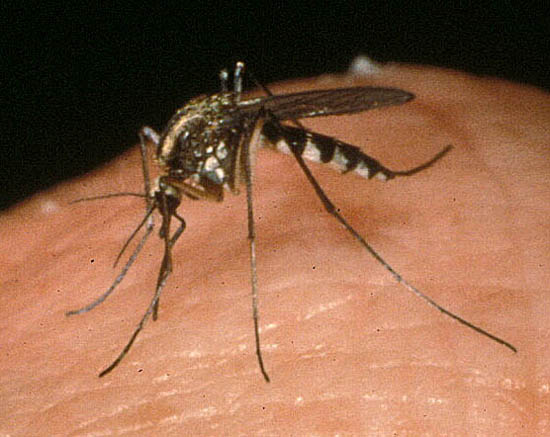Issue 4, May 15, 2009
Mosquitoes
Repeated heavy rainfall over the state has resulted in a lot of flooding of low-lying areas. This, along with the rising temperatures as we head towards summer, is setting us up for a heavy floodwater mosquito season.
There are three main groups of mosquito life cycles. One group is the permanent pool group that reproduces in relatively small numbers in established lakes and ponds. The Anopheles mosquitoes capable of carrying malaria are in this group. The second group is the container breeding mosquitoes that prefer stagnant water and become more numerous during the summer when rainfall is minimal. The northern house mosquito, Culex pipiens, the main vector of West Nile Virus and St. Louis Encephalitis, is in this group. Floodwater mosquitoes are the third group.
Floodwater mosquitoes lay their eggs on low-lying dry soil. These eggs are very resistant, retaining a high hatch percentage for two years or more. When heavy rains flood these areas, the eggs hatch into larvae that feed on debris in the water. As rainfall continues, and flood waters rise higher, continually more eggs are flooded and hatch. Repeated heavy rainfalls as we are experiencing this spring cause huge numbers of eggs to hatch.
If the water temperature stays below 50 degrees F, the mosquito larvae develop very slowly, resulting in a high percentage of them dying from disease. For that reason, heavy rains in the late winter or early spring frequently do not result in high numbers of biting mosquitoes. With warmer temperatures, the larvae develop quickly and relatively small numbers die from disease. Generally, from mid-May through the summer, we can expect high numbers of biting mosquitoes to occur about fifteen days after a heavy rainfall. This is the length of time required for egg hatch, larval development, and the pupal stage to complete, resulting in biting mosquitoes.
Outbreaks of adult mosquitoes are relatively short-lived because many other insects, birds, and other animals eat them. High numbers usually occur for 3-5 days, occasionally lasting for a week. To understand the importance of predation, adult mosquitoes live for about two weeks before dying of old age. Both male and female adult mosquitoes primarily feed on flower nectar, but female mosquitoes feed on blood to obtain the protein needed to produce eggs.
The most common Illinois mosquito in this group is the inland floodwater mosquito, Aedes vexans. It is a noisy biter, meaning that you hear it buzzing by your ears and produces a bite that is easily felt. It is an excellent flier, being able to fly 30 miles or more and commonly being found 15 miles from where it grew up. This results in huge numbers entering urban areas from outlying flooded areas. When numerous, they drive people indoors to escape their buzzing and biting.

Another noticeable floodwater mosquito is the gallinipper, Psorophora ciliata. It is perhaps our largest mosquito, being about one-half inch long with a larger leg span. Although a vicious biter, its larva feeds on other mosquito larvae, reducing the number of inland floodwater mosquitoes. Although common, the gallinipper is much less numerous than the inland floodwater mosquito.
Although floodwater mosquitoes are not serious disease vectors, their biting is distracting. Repellents containing DEET or picaridin are sold in major brands such as Off and Cutters. Soybean oil repellent is sold as Bite Blocker. All three are effective, lasting over an hour per application, and commonly several hours. Herbal repellents, Skin-So-Soft, and other materials are considerably less effective and/or are effective for much less than an hour. Repellents containing 20-30% DEET are the most effective in repellency and longevity. Higher concentrations of DEET do not last as long, probably because the lotion components in lower concentration products reduce evaporation. There are also permethrin (Permanone) containing clothes treatments that will kill mosquitoes and other insects landing on the clothing.--Phil Nixon
Author:
Phil Nixon